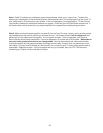When you are using analog inputs, you will probably need to manually select the proper operating mode.
However, the GTP-760 remembers the mode you’ve most recently used for a particular input and will
automatically restore that mode when you use that input next, software permitting, of course.
You can change modes with the menu system or with the surround mode button when you wish.
The GTP-760’s operating modes are:
• DTS: This mode applies only when a DTS signal is present at the selected digital input (DVD, digital
1, or digital 2). DTS is an advanced six-channel (5.1) sound format primarily used for movie
soundtracks, but also some audio only recordings. DTS encoded programming can use
anywhere from a single channel to six channels during some aspects of a performance to
deliver the greatest sonic impact. Your GTP-760 will automatically engage the DTS mode if it
detects a DTS encoded source signal.
• Dolby Digital: This mode applies only when a Dolby Digital signal is present at the selected digital
input (DVD, digital 1, or digital 2). Contrary to popular belief, Dolby Digital does
not always
imply a discrete 5.1 channel soundtrack. While many DVDs are 5.1 channel encoded, a large
number have only 2 encoded channels. The GTP-760 automatically detects either case. If the
front panel Dolby Digital indicatorlights alone, the soundtrack is 5.1 channel encoded. If the
Dolby Digital indicator and the Dolby Pro Logic indicator light simultaneously, the soundtrack is
a 2 channel encoded Pro Logic track. Dolby Digital is alternatively called AC-3, an earlier
designation for this software scheme.
• Cinema: Not an actual mode itself, “cinema” is an equalization (“EQ”) curve designed to reduce
excessive high frequencies and the consequent harshness sometimes encountered in movie
soundtracks originally mixed strictly for theatrical release. “Cinema” can be used in conjunction
with Dolby Digital or Dolby Pro Logic.
• Dolby Pro Logic: This mode is available for all analog inputs and for digital inputs playing standard
CD audio (PCM). This is the surround mode of choice for most videotapes, surround-encoded
TV broadcasts, and some music CDs and movie soundtracks.
• Symphony Hall: This mode emulates the expansive space of a typical concert hall and is available
for all two-channel sources,
analog
as well as
PCM digital.
The subwoofer channel is
not
active in this mode.
• Stadium: Again available only for analog and PCM digital sources, this mode re-creates the
soundfield typical of a large outdoor sporting event with long reverberation times and somewhat
rolled-off high frequency response. Again, no subwoofer output.
• Jazz Club: An analog and PCM digital source enhancement, this mode simulates the intimacy of a
very small acoustic space. Again, no subwoofer output.
• 5 channel stereo: This makes full use of a home theater speaker system when playing two-channel
only (analog or PCM digital) sources. It is ideal for parties or any other time when you want to
get the broadest possible sound distribution from a non-surround encoded source.
• 2 channel stereo: The preferred mode for traditional two-channel stereo listening. This mode is
available for both analog and digital sources. Most multi channel Dolby Digital and DTS signals
can also be mixed-down into a 2-channel format.
35


















